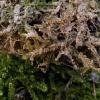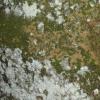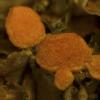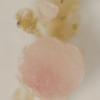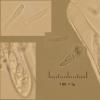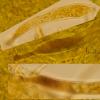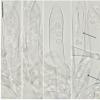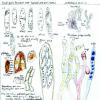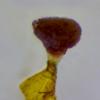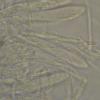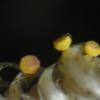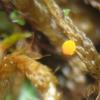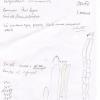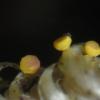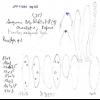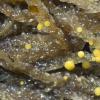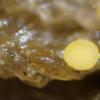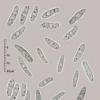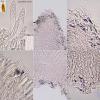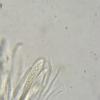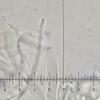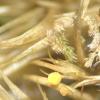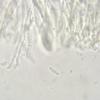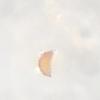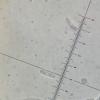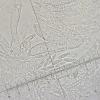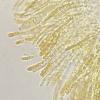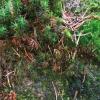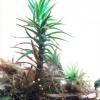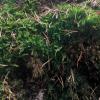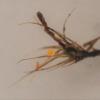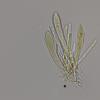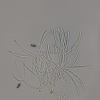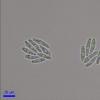
24-12-2025 17:08
Hulda Caroline HolteHello, I have found this propoloid ascomycete on

21-12-2025 09:32
Hello.A tiny ascomycete found embedded in wood in

21-12-2025 21:32
Pol DebaenstHello, Garden, Burgweg 19, Veurne, BelgiumOn 10/1

22-12-2025 23:38
Patrice TANCHAUDBonsoir, récolte sur un mur en pierre, apothéci

22-12-2025 00:47
Patrice TANCHAUDBonsoir, récolte à proximité du milieu dunaire
 Hello
HelloA small yellow Bryoscyphus sp? on moss, Pleurozium schreberi has been collected in february 2013 by Mila Tanaskovic in Fontainebleau (F).
She gave me a part of her collection and it needs to stay three weeks in the bottom of the fridge to see some spores.
apothecia are stipitate, 1-2 mm high, diam. 1 (2) mm
spores ellipsoid-fusiform, sometime with one septum, OCI low
N= 20 ; 12,3-14,8 x 2,8-3,8 Qm= 4
ascus with croziers, 60-70 x10 µm,IKI +
excipulum textura epidermoidea?
paraphysis filiform, 2 µ wide
In Zotto's dvd (pictures and Bernard Declercq's key), I found Helotium ("Bryoscyphus") phascoides that can fit this collection, but the color is white.
Have you any idea about it?
thanks in advance
cheers
François
Ca ne va pas t'aider mais j'ai déjà une récolte analogue.
JPP pourrait t'en parler, je lui avais mlis dans ses pattes, n'ayant abouti à rien.
Mes apothécies devenaient rose-orange avec l'âge, as-tu observé cela sr cette récolte ?
Alain

as tu des photos ou dessins à montrer?
Amitiés
François

it seems to be difficult to say what the color in a natural environment with daylight should be.
It could be that the color remained yellow because the lack of dayllight (UV) to bleach it.
Stip
La mousse était aussi Pleurozium schreberi, trouvé le 3-3-2011.
Il était aussi jaune que le tien.
Et j'avais noté pour la micro :
Asques octosporés J+, spores de forme et taille variable, oblongues en général mais je donne une fourchette raisonnable de 13-15 x 3-4.5 µm, guttulées, parfois 1-septées..
J'ai pas mal de photos et d'autres données si nécessaire .
M^me croziers et même paraphyses que pour ta récolte.
Alain
For Stip : it is constantly yellow, like Bisporella.
Je crois qu'au regard du tractus il était parti vers les Calycinella.
Mais Calycinella inconnu.
Très chouette en tout cas.
Je sais où le retrouver s'il le fallait.
Alain


Instead, it reminds me strongly of a fungus found on the hepatique Nowellia. I have it in my files in the genus Roseodiscus, though only because of lack of a better opinion. Yours should be the same genus though not conspecific: that on Nowellia has shorter spores an a hemiamyloid apical ring (RR). Yours is directly blue in IKI I assume.
I thought we had the Nowellia fungus already in the forum, but I cannot find it. Here is my plate and a drawing by Lothar (I never saw mature material).
Zotto

Mila told me she knew the place well, so I think that new fresh collection is possible.
I keep the exsiccatum for further investigations.
cheers
François
last year G. Bauer sent me photos and material of a similar fungus growing on Lophozia in the Bavarian Forest. I have not been able to find a name for this species either.
Attached are pictures taken by G. Bauer and his description (translated).
Best wishes,
Gernot
on mossy granite rock.
Moss: Lophozia (according to Dr. Oliver Dürhammer possibly L. ventricosa)
Apos. 0,5 - 1,5 mm, yellow-orange with lighter colored margin; underside light yellow; stipe hardly present; numerous on dead moss.
Sp. (11,5) 13-15 x 3-3,5 µ, partially 1-septate.
Asci 55-62 µ long , Melzers / IKI +, with croziers (difficult to observe)
Paraphyses filiform, septate, branched
Hairs +- straight, smooth
Conspicuity: in tap water or aqua dest. some apothecia change their color to pink, in KOH they immediately turn wine red.

Now, here is a nice drawing by Bernd Fellmann on such a Lophozia collection by Günter Bauer.
Resembles indeed that of Francois. I see that in KOH the yellow turns pink! Can you test that, Francois?
Zotto



But Alain, are you sure with Pleurozium? Your photo suggests a hepatique, perhaps Lophozia?
Zotto


I agree with you. For me at first, I recognized Lophozia (or Barbilophozia too).
I remember having sent material to JPP and he answers to me that it was also on Pleurozium shreberi.
In conclusion : Luteodiscus primoaprilus comes on both.
Alain

Zotto

About Alain collection, I called it Calycellina luteorosea. The tractus seems very close to Calycina type, but the new genera Roseodicus Baral is close too.The apos grown on Barbilophozia, Pleurozium and Hypnum cupressiforme. It's not rare when the apos are very abundant, they colonize all bryo around.
Iki were BB without KHO pretreatment. The micro agree with François pics
Apos first golden yellow becoming pinkish. Reaction koh on apos no tested.
I join micro and Alain photo with apos on Hypnum cupressiforme with curved leaves.
jpp
JPP?

Does this species already exist or is to be created?
Kenavo
Jeudi, je serai peut-être dans le secteur.
Bonne soirée à tous,
Alain
It's nice to have data of several finds now!
Best wishes,
Gernot

It might finally turn out that on all these bryophytes and liverworts the very same fungus is growing....
Zotto

JPP

- Francois' and Alain's finds on Pleurozium (etc.?) react IKI BB
- Lothar's collection on Nowellia reacts RR
- G. Bauer's collections on Lophozia appear to be RB after Bernd Fellmann's statement.
I need to check Lothar's specimen whether it turns pink in KOH. Hope that further differences exist between these...
Zotto


no news. I am still waiting for molecular data.
Zotto


Zotto


Found this one today aswell (Sweden), Match good with Francois' and Alain's finds but this is on Dicranum i believe. spores 12-15um, IKI Blue, react pink in koh 10%. ascus 8-10,5 and up to 85 um long, with croziers even thats its hard to see.
pictures seen in Koh and lugols
Regards



Hello,
I found this collection of yellow Helotiales on moss growing on granite rocks 04/10/2023 near Wunsiedel, south-eastern germany approx. 800m above sealevel. As colonized moss on that location was at least 3 different species (Polytrichum cf. commune, Dicranum spec., cf. Hypnum spec.- or Pleurozium?) at first I dismissed the idea of a moss parasite, which usually seem to be quite host-specific. Yet a colleague sent me a link to your discussion here and it looks to me like it is a related species as to what François and Alain showed here. Has "Luteodiscus" been established in the meantime?
Ascocarps were bright lemon-yellow on front and backside, width approx. 0.4-0.8mm. Margin with tiny hairs. Flat/ no apparent stem. Colour changes with KOH 5% to purple-red. Growing directly on "leaves" and "stem" (gametophytes) of mosses.
Microscopically asci were pointed like a pencil towards the tip, porus often excentric, IKI+ (BB), croziers+, approx. 70 × 8µm.
Paraphyses filiform, partially septate, sometimes branched (see pictures). Spores fusiform, yet somewhat polymorph, one end often tapering, multiguttulate, one nucleus. Size from sporecast (11.8) 12.4 - 16.4 (20.3) × (2.9) 3.1 - 3.8 (4.1) µm Q = (3.3) 3.5 - 4.9 (5.4) ; N = 41 (Piximetre, classical formula).
What do you think of it? If you need more details just ask, i still guard it in the fridge.
Thank you in andvance, merci bien
Ingo



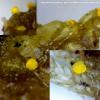
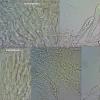

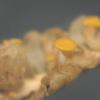

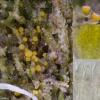
 Helotiales-HB-9478-0001.jpg
Helotiales-HB-9478-0001.jpg
